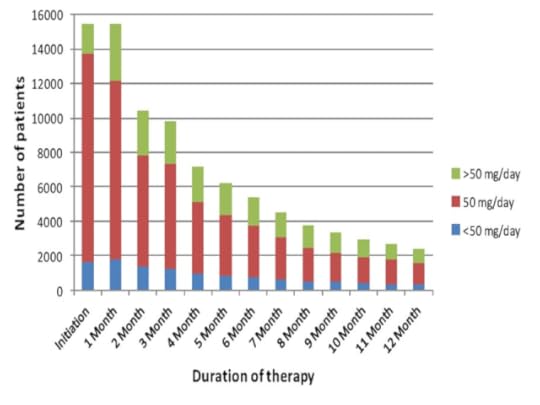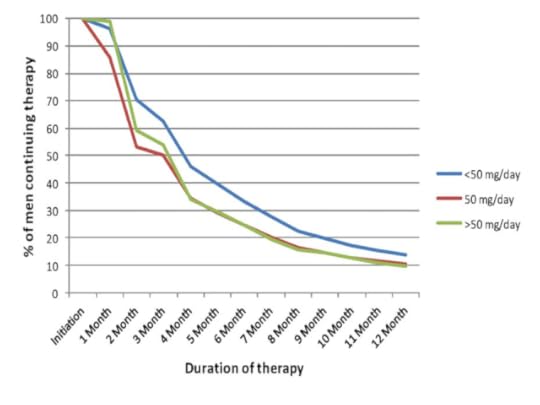Most Men on Androgel and Testim Stop Using Them


Medication Adherence and Treatment
Patterns for Hypogonadal
Patients Treated with Topical
Testosterone Therapy: A Retrospective Medical Claims Analysis
Michael Jay Schoenfeld, MA, Emily Shortridge, PhD, Zhanglin Cui, PhD, and David Muram, MD
Eli Lilly and Company,
Indianapolis, IN, USA DOI:
10.1111/jsm.12114
[image error]A B S T R A C T
Introduction . There is limited information on adherence to topical
testosterone replacement therapy (TRT) among hypogonadal
men.
Aim . To determine adherence rates among
men treated with topical
testosterone gels and to examine factors
that may influence adherence, including age, presence of a specific diagnosis, and index dose.
Methods . Included were 15,435 hypogonadal men, from the Thomson Reuters MarketScan® Database, who had an initial
topical testosterone prescription
in 2009 and who were followed
for 12 months.
Mai n Outcome Measures. Adherence to testosterone was measured by medication possession ratio (MPR), with high adherence
defined as >0.8. Persistence was defined as the
duration of therapy from the index date to the earliest
of the following events: end date of the last prescription, date of the first gap of >30 days between
prescriptions, or end of the study period (12 months).
Results .
Adherence to topical
TRT was low. By 6 months, only
34.7% of patients
had continued on medication; at 12 months, only 15.4%. Adherence rates were numerically similar among men who received
AndroGel® or Testim® topical gels and did not differ among men of different age groups. Approximately 80% of patients initiated at the recommended dose of 50 mg/day. Over time, an increased proportion of
men used a higher dose. This change was
the result of dose escalation, rather than
of greater adherence
among men initiating
therapy
at a high dose.
Dose escalation was seen as early
as 1 month into therapy.
Approximately
50%
of men who discontinued treatment resumed therapy; most men used the same medication
and dose.
Conclusions . Discontinuation
rates are high among
hypogonadal men treated
with testosterone gels, irrespective of their age, diagnosis, and index dose. Further study, evaluating other measurable factors associated with low adherence among patients
receiving topical TRT, may lead to interventions designed to improve adherence
with therapy.
COMMENTS:
About 50% of patients who were followed over time resumed
TRT. It
is possible that some patients experienced alleviation of symptoms and were not sure they needed to remain on therapy. Once therapy
was discontinued and symptoms recurred in some patients, the benefits of
replacement therapy may have become clearer; thus,
prompting
these men
to restart
therapy at the same effective
dose.
An important
limitation of the study is that claims
data do not include important patient level data, such as symptoms, reasons
for discontinuation (e.g., application
method), side effects (e.g., skin reaction), testosterone levels, responses to therapy, and so forth.
While perception of efficacy has significant effect
on patient adherence, this study was
unable to assess
severity of symptoms or of symptomatic relief, once patients initiated therapy.
The study was unable to identify characteristics that were associated with the time patients would be on therapy
before treatment was interrupted or
who would resume
therapy after a brief
interruption. Most patients
who
resumed
therapy
did
so
by using
the same
topical TRT agent and the same dose they used prior to the interruption. It is possible
that these patients
perceived efficacy,
were proficient in the application method, and possibly had a prescription that
they
were able to use or refill
without the need
for an office visit.
Only a small percentage of patients
using topical
therapy resumed therapy
by using a different method
or a change
in the dosing regimen.
Lesson:
Patients on testosterone should have their blood levels and symptoms evaluated after a few weeks on therapy. Depending on these follow up results, dose adjustment or change of delivery method should be explored as well as other issues that may potentially affect efficacy and adherence (life style, other medications, body mass index, etc). Expectations should also be clearly described at the start of therapy (for more on what to expect, read this ) so that patients have realistic views. Stamina and sexual function are multifactorial and testosterone blood levels are only part of the puzzle.

Published on March 16, 2013 05:59
No comments have been added yet.



